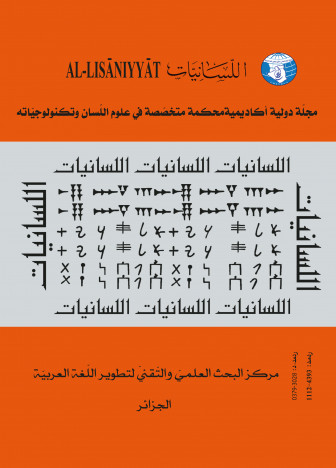Effets Cumulatifs de la Marque en Phonologie
##plugins.themes.bootstrap3.article.main##
Résumé
Ce travail porte sur la dualité des éléments marqués / non-marqués et son implication sur le
langage. Nous essayerons de mettre la lumière sur une notion universelle à haute influence sur les
études du langage, initiée par l école linguistique de Prague suite aux travaux de Troubetzkoy
(1939) et Jakobson (1941). La théorie de Marque ayant touché plusieurs domaines en linguistique,
influence également le domaine phonologique d’où notre intérêt de présenter une vision sur
l’impact de ses principes à savoir l’universalité et les critères d’implications en terme phonologique
et non-phonologique.
L’importance de la marque peut être considérée comme résolution aux problèmes de
l’acquisition phonologique de la langue seconde. Ce travail tente de démontrer l’application de la
théorie de la marque dans le travail d’Eckman (1977), Hypothèse de la Marque Différentielle, ainsi
que dans la théorie de Schmid (1997), la Naturalité Différentielle.
##plugins.themes.bootstrap3.article.details##
Références
English secondary school learners. MA thesis in Apllied Linguistics and Foreign Language Teaching.
Setif University.
Alezetes, E. D. (2007). A Markedness approach to epenthesis in Arabic speakers’L2 English. MA
thesis in English: Ball State University, Muncie, Indiana. 2004. Presented in the University of
Montana Missoula, MT.
Azieb, A & Mahadin, S. (2015). Noun diminutive formation in Algerian Arabic as used in Jijel: an
Optimaliy analyis. International Journal of Humanities and Social Science, 150, 5-12.
Broselow, E. (1984). An Investigation of transfer in second language acquisition. International
Review of Applied Linguistics, 22, 253-269.
Bruce, H. (2009). Introductory Phonology. Oxford, OX4 2DQ, UK. Blackwell by Wiley & Sons Ltd.
Bybee, J. L. (1985). Morphology: A Study of the relation between meaning and form.
Amsterdam: Benjamins, Ch.3.
Caroll, D. W. (2004). Psychology of Language. 4th ed. Belmont, CA: Wadsworth / Thomson.
Chomsky, N. (1965). Aspects of the Theory of Syntax. Cambridge, Mass: MIT Press.
Chomsky, N., & Morris, H. (1968). The Sound Pattern of English. New York, Harper and Row.
De Lacy, P. (2006). Markedness: Reudction and preservation in phonology. Cambridge Studies in
Linguistics. Cambridge. University Press.
De Lacy, P. (2007). The Cambridge Handbook of Phonology .New York, Cambridge University .
Donegan, P., & Stampe, D. (1979). The Study of natural phonology. En: Dinnsen, D.A, Current
approaches to phonological theory. Bloomington, London University Press.
Dresher, B. E. (2008). The Contrastive hierarchy in phonology. Department ofLinguistics. University
of Toronto. Toronto, Ontario. Canada M5S3H1.
Eckman, R. (1977). Markedness and the contrastive analysis hypothesis: Language Learning, 27,
315-330.
Eckman, R. (2003). Typological markedness and second language phonology.
Ms.Under consideration for Zampini and Hansen (Eds). University of Wisconsin-Milwaukee.
Cambridge University Press. Milwaukee, W53201.
Galal, M. (2004). An OT approach to loanword adaptation in Cairene Arabic. In O.
Abdel-Ghafer, B. Montgomery-Anderson, and. Parafita Couto,M (Eds.), 68 Kansas Working Papers
in Linguistics, 27.
Greenberg, J. (1976). Language Universals. The Hague. Mouton.
Gundel, J, K., & Sanders, G. (1986). Markeddness distribution in phonology and syntax. In Eckman,F,
Moravcsik,E & Wirth, J. Markeddness. New York. Plenum Press .
Haye, B. (2009). Introductory phonology. Blackwell by Wiley & Sons Ltd .Oxford, OX4 2DQ, UK.
Hall, T.A. (2007). Segmental phenomena. Part 3 in De Lacy, P. (2006). Markedness: Reudction and
preservation in phonology. Cambridge.Studies in Linguistics. Cambridge University Press.
Haoues, A.S. (2008). Code variaiton among Algerian Universiyt students. PhD thesis in Linguistis.
Constantine University.
Hooper, J. L. (1976). An Introduction to natural phonology. New York. Academic Press.
Hockett, C. F. (1966). The Problem of universals in language. In Greenberg, J. H (Ed), Universals of
language (2nd ed). Cambridge, MA: Mitt Press.
Hjelmslev, L. (1935). La Categorie des cas I: Acta Jutandica Aarhus Copenhagen and Munich.
Jakobson, R. (1941). Child language: Aphasia and phonological universals. The Hague. Mouton.
Kager, R. (1999). Optimality theory. Foreign Language Teaching and Press. Cambridge University
Press.
Kean, M. (1975). The theory of markedness in generative grammar. PhD dissertation, MTA.
Kisparsky. (1985). Some consequences of lexical phonology. In Ewen,C .,& Kaisse,E. Phonology year
book (2). Cambridge University Press.
Lado, R. (1957). Linguistics across cultures. Arizona State University: Tempe. Arbor, A.
Martinet, A. (1957). Economie des changements phonétique. The American Journal of Philosophy,
78, No. 4, 433-440.
McCarthy, J., & Prince, A. (1993). Generalized alignment. In Booij,G., & Van Marle,J (eds).
Dordrecht: Kluwer, pp. 79-153.
McCarthy, J., & Prince, A. (1993).Prosodic morphology I: Constraint interaction and satisfaction.
University of Massachusetts. Amherst & Rutgers University.
McCarthy, J. (1995). Extensions of faithfulness. Rotuman Revisited. Ms. UMass, Amherst.
Paradis, C., & La Charite, D. (1997). Preservation and minimality in loanword adaptation. Journal of
Linguistics, 33,379-430
Prince, A., & Smolensky, P. (1993). Optimality theory: Constraint interaction in generative grammar:
Rutgers University and the University of Colorado at Bouder.
Schmid, S. (1997). The Naturalness differential hypothesis: Cross-Linguistic influences and
universal preferences in interlanguage phonology and morphology. Folia Linguistica XXX, 13-4,
331-348.
Stampe. (1972). How I spent my summer vacation. PhD dissertation on Natural Phonology:
University of Chicago. New York. Garland.
Trubetzkoy, N. (1939). Principles of Phonology. Paris: Klincksiec.
